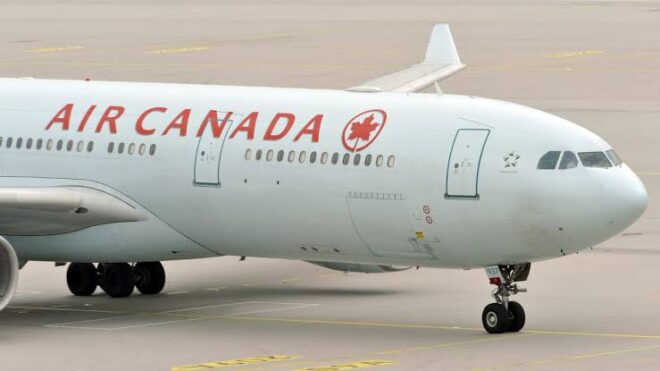
An Air Canada flight, en route from Vancouver to Sydney, was forced to make an emergency landing in Hawaii after sudden, intense turbulence injured 37 passengers and crew members. The Boeing 777-200, carrying 284 people, encountered what’s known as clear air turbulence (CAT) approximately two hours past Hawaii, prompting immediate action by the crew to prioritize passenger safety.
Among those injured, 30 passengers were transported to hospitals in Honolulu, with nine reportedly sustaining severe injuries. Photographs shared by passengers reveal the extent of the chaos on board: oxygen masks dangled from overhead compartments, service trolleys were overturned, and blood marked parts of the cabin where passengers had collided with seats and overhead structures. “We all hit the roof,” passenger Jess Smith recounted to local media, adding that “people went flying” as the turbulence struck without warning.

Witnesses also described the cabin as “a scene of panic and shock.” Alex Macdonald, another passenger, told CBC News that people in front of her were violently thrust upward and back into their seats, colliding with the baggage compartments above. An Instagram post shared by a fellow traveler depicted passengers wearing neck braces at the airport following the ordeal, highlighting the forceful impact they endured.
The turbulence was so severe that even seasoned travelers and the flight crew were unprepared for its suddenness. Aboard the flight was the Australian country band Hurricane Fall, whose members had minor injuries. The band later shared on social media that their vocalist had received medical care for injuries to his arm and elbow before being discharged from the hospital.
Air Canada issued a statement shortly after, confirming that all those who had been hospitalized were later assessed, treated, and released. The airline further assured travelers that passengers had been accommodated in nearby hotels and the flight was scheduled to resume service the next day. The aircraft had touched down in Honolulu at 06:46 local time on Thursday morning, where emergency services awaited its arrival.
Clear air turbulence, often referred to as CAT, poses a unique and largely invisible challenge to pilots and passengers alike. Unlike typical turbulence, which is often associated with clouds or stormy weather, CAT strikes in clear blue skies. It occurs when opposing streams of fast-moving air create unseen air currents, often at high altitudes where radar systems have difficulty detecting them. Without visual indicators or radar detection, pilots must rely on reports from other planes, shared through air traffic control, to help guide them around areas of CAT.
Unfortunately, on the Air Canada flight, this turbulence was so unexpected that even the crew was unable to anticipate its onset. The unpredictability of clear air turbulence is precisely why airlines encourage passengers to wear seatbelts whenever seated, regardless of current weather conditions.
Experts emphasize that while severe injuries from turbulence are rare, these incidents can be minimized by following recommended safety protocols. Flight instructors and airline staff often stress that turbulence, while uncomfortable, is generally harmless if precautions are taken.
The Air Canada incident, however, serves as a potent reminder of just how powerful and disorienting turbulence can be. Even though airplanes are designed to withstand significant turbulence, passengers are vulnerable if they’re not securely fastened. In severe cases like this, unsecured passengers and loose items can be flung around the cabin with substantial force, causing injuries to themselves and others nearby. The sight of dangling oxygen masks and toppled carts only reinforces the extreme nature of the event.
Clear air turbulence remains one of the greatest challenges in air travel safety, as technology has yet to catch up with its invisibility and unpredictability. Unlike thunderstorms or clouds, which can often be seen or tracked by radar, CAT operates almost like an “invisible storm,” striking without warning. Some advancements are being explored, such as the use of satellite data to better predict high-risk turbulence zones. However, fully reliable forecasting is still a work in progress, meaning pilots and passengers alike must stay vigilant for unexpected jolts during flights.
The unpredictability of CAT has prompted many airlines, including Air Canada, to train flight crews extensively on responding to sudden turbulence incidents. In cases of extreme turbulence, the primary focus for cabin crew is to ensure passenger safety and minimize chaos in the cabin. Crews are trained to brace for impact, secure themselves quickly, and then assist passengers, ensuring they understand the procedures and instructions.
This recent event also underscores the crucial role of communication in crisis management. After the plane diverted to Hawaii, Air Canada promptly coordinated with emergency response teams on the ground, allowing for rapid medical response. Passengers were kept informed, and the airline worked to provide accommodation and reschedule flights, demonstrating the importance of swift and transparent communication in easing passenger distress after such a traumatic experience.
Passengers and crew may take comfort in knowing that such incidents are statistically rare, even though turbulence itself is common. Industry experts remind the public that turbulence, while uncomfortable, is usually manageable and is not indicative of any structural danger to the aircraft. Aircraft are designed to withstand forces far beyond those typically encountered in turbulence, even in extreme cases like this. Nevertheless, turbulence-related injuries occur primarily when people are unbelted or moving about the cabin during a sudden disturbance.
Incidents like this often reignite debates about whether airlines should require passengers to wear seatbelts at all times, a rule currently enforced primarily during takeoff, landing, and periods of active turbulence. While some passengers find this restriction inconvenient, it’s a preventive measure that significantly reduces the risk of injury. In recent years, airlines have begun providing more extensive turbulence warnings to their passengers, encouraging them to remain seated and belted whenever possible.
For many passengers, the incident will leave a lasting impression and may even heighten anxiety about flying. Nonetheless, aviation experts advise that while turbulence can be unsettling, it rarely compromises aircraft safety. Safety protocols, crew training, and aircraft engineering are all geared toward ensuring that passengers remain as safe as possible, even in the face of sudden turbulence.
Ultimately, the Air Canada turbulence incident is a sobering reminder of the unpredictability of air travel and the importance of following safety guidelines. It serves as a call to action for continued advancements in turbulence detection technology and reinforces the value of cooperation among airlines, aviation authorities, and researchers to make the skies even safer for everyone.